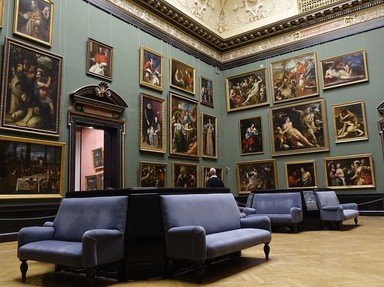Quiz Answer Key and Fun Facts
1. 'The Gleaners' was painted in 1857 by Jean-François Millet, who is known for using peasant farmers as the subject matter for much of his work. He was one of the founders of a painting school, named after a village near which a group of the artists worked. What was this group called?
2. When Édouard Manet's painting, then titled 'Le Bain' ('The Bath'), was rejected in 1863 after he submitted it to the Paris Salon, the official annual exhibition of the Académie des Beaux-Arts, he decided to join with a number of other innovative artists whose works had been rejected to participate in an alternative show called the Salon des Refusés. This exhibition was one of the pivotal moments in establishing the reputations of the artists who were to become known as members of which movement?
3. Edgar Degas started out as an historical painter, but, influenced by Édouard Manet, he changed to contemporary subjects, such as the café patrons shown here, in a painting originally produced in 1873, but which received its current title, 'L'Absinthe' ('The Absinthe Drinker' or 'Glass of Absinthe'), when it was displayed in London in 1893. Although it is typical of Degas's style, it is not typical of his subject matter. Which of these were the subject of over half of his paintings, prints and drawings?
4. The 1876 painting 'Bal du moulin de la Galette' ('Dance at the Moulin de Galette') shows patrons of the mill engaged in activities typical of a Sunday afternoon there - dancing, eating (especially the cakes called galettes, made from flour ground at the mill) and drinking, both alcoholic and non-alcoholic beverages. Its painter may be better known for his later focus on nudes, but this is typical of his earlier 'en plein air' work. Which Impressionist produced this painting?
5. 'Le Repos au bord d'un ruisseau. Lisière de bois' ('Rest Along the Stream. Edge of the Wood') was painted in 1878 by a painter who had been born (of English parents) and raised in France, where he spent most of his life. Which of these was it?
6. The 1879 painting 'Châtaigniers à Louveciennes' ('Chestnut Grove at Louveciennes') was produced by a painter known as a leading member of both the Impressionist and Neo-Impressionist movements. Indeed, his decision to abandon Impressionism is sometimes seen as defining the end of that movement. Camille Pissarro is often called the Father of Impressionism, and is identified by most as a French painter. However, his first years of professional painting were carried out in which far-removed country?
7. This 1888 painting titled 'Starry Night over the Rhône' was painted while Vincent van Gogh was living in Arles, staying at the Yellow House a few minutes' walk from the river. A more famous sequel, 'The Starry Night', was painted in 1889. Where was van Gogh residing when he painted it?
8. 'Le Cerq' ('The Circus') was the third painting from Georges Seurat in a circus-themed series. His final painting, it was still unfinished at the time of his death. Like much of his work, it is composed of only primary colors, applied in dots to create the image, a fuller range of colors being produced by the appropriate placement of the dots. What was this technique derisively named by its early critics?
9. When I tell you that the title of this 1891 painting is 'Tahitian Women on the Beach', you will probably have a good idea who painted it, even if you did not instantly recognise his style. Which Post-Impressionist painter spent the last years of his life in French Polynesia, where he died on 8 May 1903?
10. Paul Cezanne painted 'Apples and Oranges' in 1899, as one of a series of six paintings in what genre?
Source: Author
looney_tunes
This quiz was reviewed by FunTrivia editor
ponycargirl before going online.
Any errors found in FunTrivia content are routinely corrected through our feedback system.
